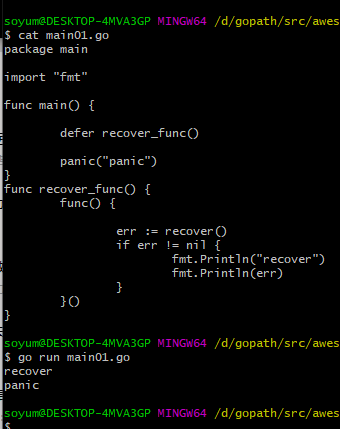
事情起因是因为上班无聊水群(此处领导不可见),发现群里有小伙伴提了个关于 recover 捕获 panic 的问题
代码1:
func main() {
defer recover_func()
panic("panic")
}
func recover_func() {
func() {
err := recover()
if err != nil {
fmt.Println("recover")
fmt.Println(err)
}
}()
}
//out put: panic: panic
代码2
func main() {
defer recover_func()
panic("panic")
}
func recover_func() {
err := recover()
if err != nil {
fmt.Println("recover")
fmt.Println(err)
}
}
//out put: recover
// panic
由上代码可见,代码1无法成功recover捕获panic,而代码2能正常捕获。
这成功触及到了我的知识盲区。于是决定探索一下panic和recover的奥秘。
首先我们需要找到panic在go中的源码。
TEXT "".main(SB), ABIInternal, $24-0
MOVQ (TLS), CX
CMPQ SP, 16(CX)
JLS 59
SUBQ $24, SP
MOVQ BP, 16(SP)
LEAQ 16(SP), BP
FUNCDATA $0, gclocals·33cdeccccebe80329f1fdbee7f5874cb(SB)
FUNCDATA $1, gclocals·33cdeccccebe80329f1fdbee7f5874cb(SB)
FUNCDATA $3, gclocals·9fb7f0986f647f17cb53dda1484e0f7a(SB)
PCDATA $2, $1
PCDATA $0, $0
LEAQ type.string(SB), AX
PCDATA $2, $0
MOVQ AX, (SP)
PCDATA $2, $1
LEAQ "".statictmp_0(SB), AX
PCDATA $2, $0
MOVQ AX, 8(SP)
CALL runtime.gopanic(SB)
UNDEF
NOP
PCDATA $0, $-1
PCDATA $2, $-1
CALL runtime.morestack_noctxt(SB)
JMP 0
可见panic源码在runtime.gopanic() 这个方法中。
func gopanic(e interface{}) {
gp := getg()
....省略代码
//产生一个新的panic
var p _panic
p.arg = e
p.link = gp._panic
gp._panic = (*_panic)(noescape(unsafe.Pointer(&p)))
atomic.Xadd(&runningPanicDefers, 1)
for {
// 从当前g获取一个defer
d := gp._defer
if d == nil { //如果当前g不存在defer 那么直接退出
break
}
// If defer was started by earlier panic or Goexit (and, since we're back here, that triggered a new panic),
// take defer off list. The earlier panic or Goexit will not continue running.
if d.started { //这里判断这个defer方法是否被执行过 如果被执行过就获取defer中link字段指向的下一个defer
if d._panic != nil {
d._panic.aborted = true
}
d._panic = nil
d.fn = nil
gp._defer = d.link
freedefer(d)
continue
}
// Mark defer as started, but keep on list, so that traceback
// can find and update the defer's argument frame if stack growth
// or a garbage collection happens before reflectcall starts executing d.fn.
d.started = true //这里把defer状态修改为已经执行
// Record the panic that is running the defer.
// If there is a new panic during the deferred call, that panic
// will find d in the list and will mark d._panic (this panic) aborted.
d._panic = (*_panic)(noescape(unsafe.Pointer(&p)))
p.argp = unsafe.Pointer(getargp(0))
reflectcall(nil, unsafe.Pointer(d.fn), deferArgs(d), uint32(d.siz), uint32(d.siz))
p.argp = nil
// reflectcall did not panic. Remove d.
if gp._defer != d {
throw("bad defer entry in panic")
}
d._panic = nil
d.fn = nil
gp._defer = d.link
// trigger shrinkage to test stack copy. See stack_test.go:TestStackPanic
//GC()
//获取当前的pc寄存器
pc := d.pc
sp := unsafe.Pointer(d.sp) // must be pointer so it gets adjusted during stack copy
freedefer(d)
if p.recovered {//如果这个panic已经被recovered处理了
atomic.Xadd(&runningPanicDefers, -1)
//获取此panic的上一个panic
gp._panic = p.link
// Aborted panics are marked but remain on the g.panic list.
// Remove them from the list.
for gp._panic != nil && gp._panic.aborted {
gp._panic = gp._panic.link
}
if gp._panic == nil { // must be done with signal
gp.sig = 0
}
// Pass information about recovering frame to recovery.
gp.sigcode0 = uintptr(sp)
gp.sigcode1 = pc
mcall(recovery)
throw("recovery failed") // mcall should not return
}
}
// ran out of deferred calls - old-school panic now
// Because it is unsafe to call arbitrary user code after freezing
// the world, we call preprintpanics to invoke all necessary Error
// and String methods to prepare the panic strings before startpanic.
preprintpanics(gp._panic)
fatalpanic(gp._panic) // should not return
*(*int)(nil) = 0 // not reached
}
由上面代码可以了解到,其实panic方法就是向我们当前g赋值了一个_panic结构体。
看下_panic 结构体
type _panic struct {
argp unsafe.Pointer // pointer to arguments of deferred call run during panic; cannot move - known to liblink
arg interface{} // argument to panic
link *_panic // link to earlier panic
recovered bool // whether this panic is over
aborted bool // the panic was aborted
}
它其实是一个连表结构link元素指向它的上一个_panic。
阅读了gopanic方法后,大致明白它干了件什么事情。
在再用panic方法后,会把当前g的defer依次执行,每执行一次就判断一次panic是否被recover处理。如果没有被处理那么就进行下一次循环,直到当前g的defer方法耗尽,defer耗尽后就进行old-school 的panic做法。
如果在过程中发现panic被recover处理了,那么就执行recovery方法,进行一次上下文跳转,类似于linux内核中进程调度一样的操作,重置PC寄存器的值,跳转到g当前defer方法的PC位子。
那么我们来看下具体处理的recover方法:
func gorecover(argp uintptr) interface{} {
// Must be in a function running as part of a deferred call during the panic.
// Must be called from the topmost function of the call
// (the function used in the defer statement).
// p.argp is the argument pointer of that topmost deferred function call.
// Compare against argp reported by caller.
// If they match, the caller is the one who can recover.
gp := getg()
p := gp._panic
if p != nil && !p.recovered && argp == uintptr(p.argp) {
p.recovered = true
return p.arg
}
return nil
}
recover方法干了件非常简单的事情,把当前g的_panic中的recovered修改为true,并且返回panic的arg。
看到这里算是把panic做的事情搞明白了,于是逐渐忘记了小伙伴的问题。
其实小伙伴的问题是在recover方法中发生的,recover方法需要判断 argp == uintptr(p.argp) ,argp是调用reccover 的方法指针,p.argp则是在gopanic方法中赋值的一个 uintptr(0),而argp参数来源是reflectcall(nil, unsafe.Pointer(d.fn), deferArgs(d), uint32(d.siz), uint32(d.siz)) 中的 deferArgs(d) ,在gopanic 中两者相等所以能通过gorecover的判断。但是文章开头的 代码1 那么此处的argp参数为func闭包指针,与panic的argp不相等,所以代码1无法recover panic。
所以看到最后我还是不明白为什么golang会这样设计,于是我删除了argp == uintptr(p.argp)…..

舒服了
29 Aug 2020